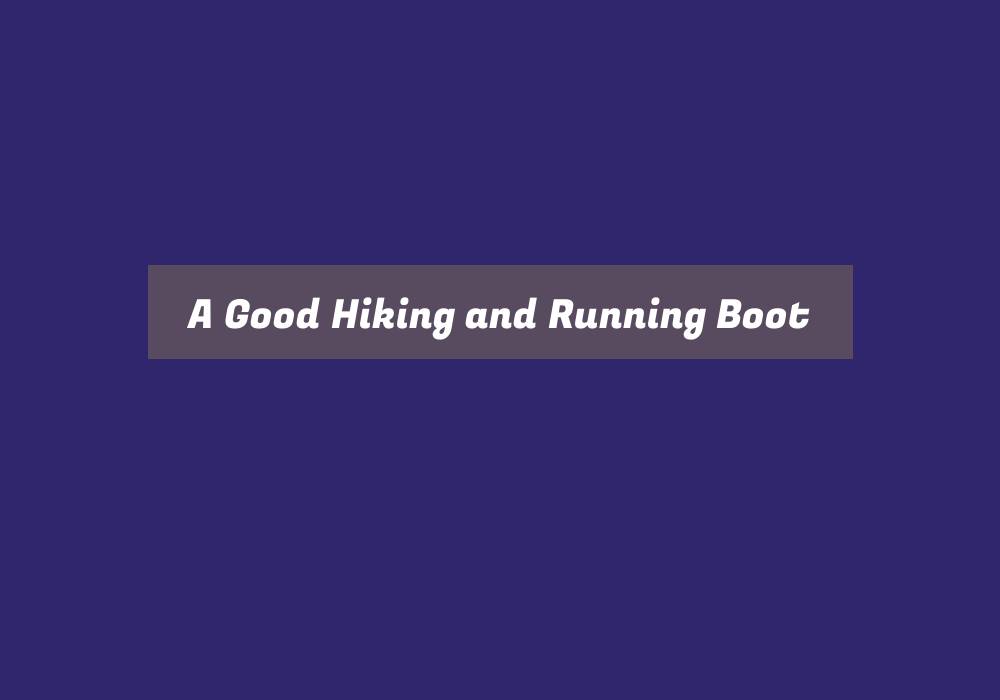Finding footwear that works well for both hiking and running can maximize your shoe closet while still providing the performance you need. The right hiking and running boot allows you to confidently tackle all types of terrain on the trail, from muddy paths to rocky ridges.
When choosing a dual hiking and running boot, you’ll want to consider factors like weight, traction, cushioning, support, breathability, and flexibility. The ideal hybrid boot balances durability for hiking with enough athletic responsiveness for running gait and adequate foot protection for varied topography.
This comprehensive guide covers everything you need to know about how to select a boot that excels at both hiking and running duties. Let’s explore the features that make a boot adept on the trail!
Hybrid Hiking and Running Boot Features
Here are the top features to look for in a high-performing hiking and running boot:
- Mid-cut height – Ankle support without restricting mobility
- Breathable upper – Allows ventilation to keep feet cool and dry
- Protective toe cap – Guards toes from trail obstacles
- Grippy outsole – Brakes and sticks on slick terrain
- Cushioned midsole – Absorbs impact while running
- Stable shank – Provides torsional rigidity for balance
- Secure lacing – Snug fit that prevents rubbing blisters
- Reasonable weight – Light enough for running without sacrificing durability
Sole/Outsole Construction
The sole and outsole are key components that determine traction and grip over varied terrain:
- Lug pattern – Multi-directional lugs bite into loose or slick ground
- Rubber compound – Durable sticky rubber boosts traction
- Rock plate – Thin shank protects soles from bruising on rocky trails
- Flex grooves – allow natural flexing of the foot during running strides
- Heel brake – Provides control on steep descending sections
Upper Materials and Structure
Well-designed uppers provide foot stability, protection, and ventilation:
- Synthetic leather and mesh – Withstands scrapes while allowing airflow
- Welded overlays – Offers structure while reducing irritation seams
- Protective rand – Wraps toe box and heels against knocks and stubs
- Ankle foam padding – Prevents rubbing and hot spots at the collar
- Gusseted tongue – Keeps out dirt and debris where the tongue attaches
Midsole Cushioning System
The midsole cushions foot strike impact and absorbs trail shocks:
- EVA foam – Lightweight with responsive bounce and cushioning
- Shock absorbing pads – Placed in heel and forefoot zones
- Rocker profile – Rolls foot smoothly through the stride
- Arch support – Contoured or shank-based support
Weight
Ideally 14-25 ounces per boot. Weighs enough for hiking protection without tiring legs during runs.
Ideal Lacing Structure
Secure yet flexible lacing optimizes fit:
- Combination eyelet and hook lacing – Secures upper while allowing adjustability
- Padded tongue – Prevents lacing pressure
- Heel locking loops – Wrap laces around the heel to prevent slippage
Finding the Right Fit
Visit a specialty store for a professional fitting:
- Bring socks you’ll wear hiking and running
- Try boots on at the end of the day when your feet are the largest
- Toes should have wiggle room – should not strike the front of the boot
- The heel should be secure with minimal lift when walking
- Laces should crank down snugly but not bite or cause pinch points
Breaking in Your New Boots
Wearing it helps soften materials:
- Before longer hikes, walk around home in boots to start breaking in
- Target 2-3 shorter hike outings to further break in before long distances
- Monitor for hot spots and blisters, and treat them immediately
- Consider aftermarket insoles if necessary for maximum comfort
Keeping Boots in Top Shape
Follow care procedures to maximize boot lifespan:
- Rinse mud after each use once dirt dries, don’t soak leather
- Stuff with newspaper or boot shapers when storing to retain shape
- Clean grime with a gentle brush and leather cleaner/conditioner
- Wash insoles regularly
- Replace insoles every 300-500 miles
- Get heels and seams repaired promptly when worn
Matching Terrain to Boots
Consider boot features suitable for each trail:
Hiking
- Rugged lug sole grips gravel, mud, inclines
- Stiff midsole stabilizes packs
- Waterproofing tackles streams and rain
Running
- Lightweight construction avoids tiring legs
- Flexible sole mirrors natural foot motion
- Breathable upper prevents overheating
Scrambling
- Toe protection for stubbing rocks
- Ankle support and grip for unstable surfaces
- Braking sole for controlled descents
Examples of Top-Rated Hiking and Running Boots
La Sportiva Ultra Raptor II Mid
- Aggressive sole and protective upper ideal for fast packing over varied terrain
- Shock-absorbing EVA midsole with stiffness for stability under load
- Light enough for trail running yet substantial for hiking
Salomon X Ultra 4 Mid
- The athletic design makes these responsive when moving fast over trails
- Protective features include a toe cap, heel foam, and lace guard
- Designed to secure heel and provide cushioning even during quicker movement
HOKA One One Tor Ultra Hi
- Maximizes comfort over long miles with thick cushioning
- Vibram outsole and Meta-Rocker profile add grip and stability
- Breathable upper dries quickly when wet and keeps feet ventilated
Conclusion
Choosing footwear versatile enough for both hiking and running terrain allows you to get double duty from your boots. Seek out key features like adequate ankle support, cushioning, traction, and protection without unnecessary bulk. Test out boots to find the best hybrid model that fits your feet and the types of adventures you tackle. Get ready to log both trail miles and road miles while only packing one reliable pair of boots.
Frequently Asked Questions About Hiking and Running Boots
What features make a boot suitable for both hiking and running?
Key factors are a grippy sole, breathable upper, athletic cushioning, protective elements like a toe cap, reasonable weight, and a secure yet flexible lacing system.
How should the fit differ between hiking and running boots?
Hiking boots fit more snugly while running boots have a bit more room for foot expansion and toe splay when at speed. Find a happy medium.
What sole construction works best for both hiking and running?
Look for deep, multi-directional lugs for traction plus flex grooves or segments that allow the sole to bend naturally with running strides.
Why is a protective upper still important in a running boot?
Hazards like stubbing toes on rocks can happen at faster speeds, so reinforcement like toe rands helps avoid injury when trail running.
How can I break in new hiking and running boots?
Pre-break them in by wearing them around the home, then do a few short hike outings before tackling long distances. Monitor for hot spots.
Will waterproofing sacrifice breathability in a hiking/running boot?
Look for models utilizing newer waterproof yet breathable membranes like Gore-Tex that resist exterior water while still venting interior vapor.
How do I clean mud or dirt from suede or nubuck leather hiking/running boots?
Let mud dry completely, then brush off debris with a stiff brush. Use a gentle leather cleaner and brush gently to lift dirt. Avoid soaking.
What weight range should I look for in a hiking/running boot?
The ideal weight is around 14-25 ounces per boot. Much over 25 ounces is too heavy for running, while under 14 ounces compromises hiking protection and support.
Should I choose standard or wide widths when sizing hiking/running boots?
Try on both to determine the best fit for your foot shape. Many brands now offer multiple widths for a dialed fit.
Can insoles help make a hiking boot work better for running?
Yes, consider swapping stock insoles for an aftermarket pair with extra arch support, responsiveness, and shock absorption ideal for running.
Can hiking and running boots multi-task well in winter conditions too?
Models with moderate insulation, waterproofing, and lug sole traction can serve during colder months, especially when paired with good wool socks.
Do I need separate boots for trail running and road running?
Trail running boots work well on pavement too. Just swap out aftermarket insoles optimized for the different terrain if doing both.
Do hiking/running boot soles eventually wear out? When?
Inspect sole lugs regularly for signs of excessive wear. The average lifespan is 300-500 miles of mixed-use before needing replacement.
Should I re-waterproof my hiking/running boots periodically?
Yes, reapply waterproofing like Nikwax after cleaning when water repellency starts noticeably decreasing to restore performance.
Can local cobblers repair damage to hiking/running boots?
Yes, they can patch holes, reinforce seams and eyelets, replace blown-out heels, and more. This can prolong boot life.
What safety precautions should I take when hiking or running in boots?
Break them in gradually pre-trip. Carry blister care and first aid. Watch your footing carefully and use trekking poles for stability if needed.
Do I need separate boots for backpacking versus day hiking and running?
If regularly hauling a heavy pack, it’s better to have sturdier dedicated backpacking boots. Lighter boots work for day uses.
You May Also Like

My name is David James I am an adventurous hiker based in California. Through this weblog, I percentage my passion for exploring nature’s wonders, documenting breathtaking trails and hidden gemstones.



